18th century
| Millennium |
|---|
| 2nd millennium |
| Centuries |
| Timelines |
| State leaders |
| Decades |
| Categories: |
|
Births–Deaths Establishments–Disestablishments |

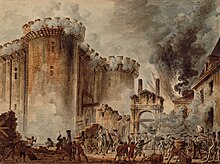


The18th centurylasted from 1 January1701(represented by theRoman numeralsMDCCI) to 31 December1800(MDCCC). During the 18th century, elements ofEnlightenmentthinking culminated in theAtlantic Revolutions.Revolutions began to challenge the legitimacy of monarchical and aristocratic power structures. TheIndustrial Revolutionbegan during mid-century, leading to radical changes inhuman societyand theenvironment.TheEuropean colonization of the Americasand other parts of the world intensified and associated mass migrations of people grew in size as part of theAge of Sail.During the century,slave tradingexpanded across the shores of theAtlantic Ocean,while declining inRussia[1]andChina.[2]
Westernhistorians have occasionally defined the 18th century otherwise for the purposes of their work. For example, the "short" 18th century may be defined as 1715–1789, denoting the period of time between the death ofLouis XIV of Franceand the start of theFrench Revolution,with an emphasis on directly interconnected events.[3][4]To historians who expand the century to include larger historical movements, the "long" 18th century[5]may run from theGlorious Revolutionof 1688 to theBattle of Waterlooin 1815[6]or even later.[7]
InEurope,philosophers ushered in the Age of Enlightenment. This period coincided with the French Revolution of 1789, and was later compromised by the excesses of theReign of Terror.At first, many monarchies of Europe embraced Enlightenment ideals, but in the wake of the French Revolution they feared loss of power and formed broad coalitions to oppose theFrench Republicin theFrench Revolutionary Wars.Various conflicts throughout the century, including theWar of the Spanish Successionand theSeven Years' War,sawGreat Britaintriumph over its rivals to become the preeminent power in Europe. However, Britain's attempts to exert its authority over theThirteen Coloniesbecame a catalyst for theAmerican Revolution.The 18th century also marked the end of thePolish–Lithuanian Commonwealthas an independent state. Its semi-democratic government system was not robust enough to preventpartitionby the neighboring states ofAustria,Prussia,and Russia.
InWest Asia,Nader ShahledPersiain successfulmilitary campaigns.TheOttoman Empireexperienced an unprecedented period of peace and economic expansion, taking no part in European wars from 1740 to 1768. As a result, the empire was not exposed to Europe's military improvements during the Seven Years' War. The Ottoman military consequently lagged behind and suffered several defeats against Russia in the second half of the century.
InSouth Asia,the death of Mughal emperorAurangzebwas followed by the expansion of theMaratha Confederacyand an increasing level of European influence and control in the region. In 1739, Persian emperor Nader Shah invaded and plundered Delhi, the capital of theMughal Empire.Later, his generalAhmad Shah Durraniscored another victory against the Marathas, the then dominant power in India, in theThird Battle of Panipatin 1761.[8]By the middle of the century, theBritish East India Companybegan to conquer eastern India,[9][8]and by the end of the century, theAnglo-Mysore WarsagainstTipu Sultanand his fatherHyder Ali,led toCompany ruleover the south.[10][11]
InEast Asia,the century marked theHigh Qing eraand the continualseclusion policyof theTokugawa shogunate.
InSoutheast Asia,theKonbaung–Ayutthaya Warsand theTây Sơn Warsbroke out while theDutch East India Companyestablishedincreasing levels of controlover theMataram Sultanate.
InAfrica,theEthiopian Empireunderwent theZemene Mesafint,a period when the country was ruled by a class of regional noblemen and the emperor was merely a figurehead. TheAtlantic slave tradealso saw the continued involvement of states such as theOyo Empire.
InOceania,the European colonization ofAustraliaandNew Zealandbegan during the late half of the century.
In theAmericas,theUnited Statesdeclared its independence from Great Britain. In 1776,Thomas Jeffersonwrote theDeclaration of Independence.In 1789,George Washingtonwas inaugurated as the first president.Benjamin Franklintraveled to Europe where he was hailed as an inventor. Examples of his inventions include thelightning rodandbifocal glasses.Túpac Amaru IIled anuprisingthat sought to endSpanish colonial rule in Peru.
Events[edit]
1701–1750[edit]


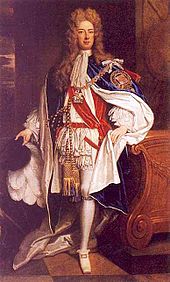
- 1700–1721:Great Northern Warbetween theRussianandSwedish Empires.
- 1701:Kingdom of Prussiadeclared under KingFrederick I.
- 1701:TheBattle of Feyiasemarks the rise of theAshanti Empire.
- 1701–1714:TheWar of the Spanish Successionis fought, involving most of continentalEurope.[12]
- 1702–1715:Camisard rebellionin France.
- 1703:Saint Petersburgis founded byPeter the Great;it is the Russiancapitaluntil1918.
- 1703–1711:TheRákóczi uprisingagainst theHabsburg monarchy.
- 1704:End of Japan'sGenrokuperiod.
- 1704:First Javanese War of Succession.[13]
- 1706–1713:The War of the Spanish Succession: French troops defeated at theBattle of Ramilliesand theSiege of Turin.
- 1707:Death of Mughal EmperorAurangzebleads to the fragmentation of theMughal Empire.
- 1707:TheAct of Unionis passed, merging the Scottish and English Parliaments, thus establishing theKingdom of Great Britain.[14]
- 1708:TheCompany of Merchants of London Trading into the East Indiesand English Company Trading to the East Indies merge to form the United Company of Merchants of England Trading to the East Indies.
- 1708–1709:Famine kills one-third ofEast Prussia's population.
- 1709:Foundation of theHotak Empire.
- 1709:TheGreat Frost of 1709marks the coldest winter in 500 years, contributing to the defeat ofSwedenatPoltava.
- 1710:The world's firstcopyright legislation,Britain'sStatute of Anne,takes effect.
- 1710–1711:Ottoman Empirefights Russia in theRusso-Turkish Warand regainsAzov.
- 1711:Bukhara Khanatedissolves as local begs seize power.
- 1711–1715:Tuscarora Warbetween British, Dutch, and German settlers and theTuscarora peopleofNorth Carolina.
- 1713:TheKangxi Emperoracknowledges the full recovery of the Chinese economy since its apex during theMing.
- 1714:In Amsterdam,Daniel Gabriel Fahrenheitinvents themercury-in-glass thermometer,which remains the most reliable and accurate thermometer until the electronic era.
- 1715:Thefirst Jacobite risingbreaks out; the British halt the Jacobite advance at theBattle of Sheriffmuir;Battle of Preston.
- 1716:Establishment of theSikh Confederacyalong the present-day India-Pakistanborder.
- 1716–1718:Austro-Venetian-Turkish War.
- 1718:The city ofNew Orleansis founded by the French in North America.
- 1718–1720:War of the Quadruple Alliancewith Spain versus France, Britain, Austria, and the Netherlands.
- 1718–1730:Tulip periodof the Ottoman Empire.
- 1719:Second Javanese War of Succession.[15]
- 1720:TheSouth Sea Bubble.
- 1720–1721:TheGreat Plague of Marseille.
- 1720:Qing forces oustDzungarinvaders fromTibet.
- 1721:TheTreaty of Nystadis signed, ending theGreat Northern War.
- 1721:Sack of Shamakhi,massacre of its Shia population bySunniLezgins.
- 1722:Siege of Isfahanresults in the handover of Iran to theHotaki Afghans.
- 1722–1723:Russo-Persian War.
- 1722–1725:Controversy overWilliam Wood's halfpence leads to theDrapier's Lettersand begins the Irish economic independence from England movement.

- 1723:Slaveryis abolished in Russia;Peter the Greatconverts householdslavesinto houseserfs.[16]
- 1723–1730:The "Great Disaster", an invasion ofKazakhterritories by theDzungars.
- 1723–1732:The Qing and the Dzungars fight a series of wars acrossQinghai,Dzungaria,andOuter Mongolia,with inconclusive results.
- 1724:Daniel Gabriel Fahrenheitproposes theFahrenheittemperature scale.
- 1725:Austro-Spanish alliancerevived. Russia joins in 1726.
- 1727–1729:Anglo-Spanish Warends inconclusively.
- 1730:Mahmud Itakes over Ottoman Empire after thePatrona Halilrevolt, ending theTulip period.
- 1730–1760:TheFirst Great Awakeningtakes place in Great Britain and North America.
- 1732–1734:Crimean Tatarraids into Russia.[17]
- 1733–1738:War of the Polish Succession.
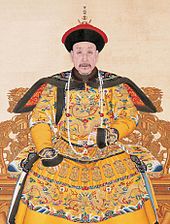
- 1735–1739:Austro-Russo-Turkish War.
- 1735–1799:TheQianlong Emperorof China oversees a huge expansion in territory.
- 1738–1756:Famineacross theSahel;half the population ofTimbuktudies.[18]
- 1737–1738:Hotak Empire ends after thesiege of KandaharbyNader Shah.
- 1739:Great Britain and Spain fight theWar of Jenkins' Earin the Caribbean.
- 1739:Nader Shah defeats a pan-Indian army of 300,000 at theBattle of Karnal.Taxation is stopped in Iran for three years.
- 1739–1740:Nader Shah's Sindh expedition.
- 1740:George Whitefieldbrings theFirst Great Awakeningto New England
- 1740–1741:Famine in Irelandkills 20 percent of the population.
- 1741–1743:Iran invadesUzbekistan,Khwarazm,Dagestan,andOman.
- 1741–1751:Maratha invasions of Bengal.
- 1740–1748:War of the Austrian Succession.
- 1742:Marvel's Mill,the first water-poweredcotton mill,begins operation in England.[19]
- 1742:Anders Celsiusproposes an inverted form of the centigrade temperature, which is later renamedCelsiusin his honor.
- 1742:Premiere ofGeorge Frideric Handel'sMessiah.
- 1743–1746:AnotherOttoman-Persian Warinvolves 375,000 men but ultimately ends in a stalemate.

- 1744:TheFirst Saudi Stateis founded byMohammed Ibn Saud.[21]
- 1744:Battle of Toulonis fought off the coast of France.
- 1744–1748:TheFirst Carnatic Waris fought between the British, the French, the Marathas, and Mysore in India.
- 1745:Second Jacobite risingis begun byCharles Edward Stuartin Scotland.
- 1747:TheDurrani Empireis founded byAhmad Shah Durrani.
- 1748:TheTreaty of Aix-La-Chapelleends the War of the Austrian Succession and First Carnatic War.
- 1748–1754:TheSecond Carnatic Waris fought between the British, the French, the Marathas, and Mysore in India.
- 1750:Peak of theLittle Ice Age.
1751–1800[edit]
- 1752:TheBritish Empireadopts theGregorian Calendar,skipping 11 days from 3 September to 13 September. On the calendar, 2 September is followed directly by 14 September.
- 1754:The Treaty of Pondicherry ends the Second Carnatic War and recognizesMuhammed Ali Khan WallajahasNawab of the Carnatic.
- 1754:King's Collegeis founded by a royal charter ofGeorge II of Great Britain.[22]
- 1754–1763:TheFrench and Indian War,the North American chapter of theSeven Years' War,is fought in colonial North America, mostly by the French and their allies against the English and their allies.
- 1755:Thegreat Lisbon earthquakedestroys most ofPortugal's capital and kills up to 100,000.
- 1755:TheDzungar genocidedepopulates much of northern Xin gian g, allowing for Han, Uyghur, Khalkha Mongol, and Manchu colonization.
- 1755–1763:TheGreat Upheavalforces transfer of the French Acadian population from Nova Scotia and New Brunswick.
- 1756–1763:TheSeven Years' Waris fought among European powers in various theaters around the world.
- 1756–1763:TheThird Carnatic Waris fought between the British, the French, and Mysore in India.
- 1757:British conquest of Bengal.

- 1760:George IIIbecomes King of Britain.
- 1761:Maratha Empiredefeated atBattle of Panipat.
- 1762–1796:Reign ofCatherine the Greatof Russia.
- 1763:TheTreaty of Parisends the Seven Years' War and Third Carnatic War.
- 1764:Dahomeyand theOyo Empiredefeat theAshanti armyat theBattle of Atakpamé.
- 1764:The Mughals are defeated at theBattle of Buxar.
- 1765:TheStamp Actis introduced into theAmerican coloniesby the British Parliament.
- 1765–1767:TheBurmese invade Thailandand utterly destroyAttuthaya.
- 1765–1769:BurmaunderHsinbyushinrepelsfour invasionsfrom Qing China, securing hegemony over theShan states.
- 1766:Christian VIIbecomes king of Denmark. He wasking of Denmarkto1808.
- 1766–1799:Anglo-Mysore Wars.
- 1767:Taksinexpels Burmese invaders and reunites Thailand under an authoritarian regime.
- 1768–1772:War of the Bar Confederation.
- 1768–1774:Russo-Turkish War.
- 1769:Spanishmissionariesestablish the first of 21missionsinCalifornia.
- 1769–1770:James Cookexplores and maps New Zealand and Australia.
- 1769–1773:TheBengal famine of 1770kills one-third of the Bengal population.
- 1769:TheFrench East India Companydissolves, only to be revived in 1785.
- 1769:French expeditions capturecloveplants inAmbon,ending theDutch East India Company's (VOC) monopoly of the plant.[23]
- 1770–1771:Famine in Czech landskills hundreds of thousands.
- 1771:ThePlague Riotin Moscow.
- 1771:TheKalmyk Khanatedissolves as the territory becomes colonized by Russians. More than a hundred thousandKalmyksmigrate back toQing Dzungaria.
- 1772:Gustav III of Swedenstages a coup d'état, becoming almost an absolute monarch.

- 1772–1779:Maratha Empire fights Britain andRaghunathrao's forces during theFirst Anglo-Maratha War.
- 1772–1795:ThePartitions of Polandend thePolish–Lithuanian Commonwealthand erase Poland from the map for 123 years.
- 1773–1775:Pugachev's Rebellion,the largest peasant revolt in Russian history.
- 1773:East India Company starts operations inBengalto smuggleopium into China.
- 1775:Russia imposes a reduction in autonomy on theZaporizhian Cossacksof Ukraine.
- 1775–1782:First Anglo-Maratha War.
- 1775–1783:American Revolutionary War.
- 1776:Severalkongsi republicsare founded by Chinese settlers in the island ofBorneo.They are some of the first democracies in Asia.
- 1776–1777:A Spanish-Portuguese Waroccurs over land in the South American frontiers.
- 1776:Illuminatifounded byAdam Weishaupt.
- 1776:TheUnited States Declaration of Independenceis adopted by theSecond Continental CongressinPhiladelphia.
- 1776:Adam SmithpublishesThe Wealth of Nations.
- 1778:James Cookbecomes the first European to land on theHawaiian Islands.
- 1778:Franco-American alliancesigned.
- 1778:Spain acquires itsfirst permanent holding in Africafrom the Portuguese, which is administered by the newly-establishedLa Plata Viceroyalty.
- 1778:Vietnamis reunified for the first time in 200 years by theTay Son brothers.TheTây Sơn dynastyhas been established, terminating theLê dynasty.
- 1779–1879:Xhosa Warsbetween British andBoersettlers and theXhosasin theSouth African Republic.
- 1779–1783:Britain loses several islands and colonial outposts all over the worldto the combined Franco-Spanish navy.
- 1779:Iran enters yet another period of conflict and civil war after the prosperous reign ofKarim Khan Zand.
- 1780:Outbreak of theindigenous rebellionagainst Spanish colonization led byTúpac Amaru IIinPeru.
- 1781:The city of Los Angeles is founded by Spanish settlers.

George Washington - 1781–1785:Serfdomis abolished in theAustrian monarchy(first step; second step in1848).
- 1782:TheThonburi Kingdomof Thailand is dissolved after a palace coup.
- 1783:TheTreaty of Parisformally ends theAmerican Revolutionary War.
- 1783:Russian annexation ofCrimea.
- 1785–1791:ImamSheikh Mansur,aChechenwarrior and Muslim mystic, leads a coalition of MuslimCaucasian tribesfrom throughout theCaucasusin aholy waragainst Russian settlers and military bases in the Caucasus, as well as against local traditionalists, who followed the traditional customs and common law (Adat) rather than the theocratic Sharia.[24]
- 1785–1795:TheNorthwest Indian Waris fought between the United States andNative Americans.
- 1785–1787:TheMaratha–Mysore Warsconcludes with an exchange of territories in theDeccan.
- 1786–1787:Wolfgang Amadeus MozartpremieresThe Marriage of FigaroandDon Giovanni.
- 1787:TheTuaregoccupy Timbuktu until the 19th century.
- 1787–1792:Russo-Turkish War.
- 1788:First Fleetarrives in Australia
- 1788–1790:Russo-Swedish War (1788–1790).
- 1788:DutchGeert Adriaans Boomgaard(1788–1899) would become the first generally accepted validated case of asupercentenarianon record.[25][26]
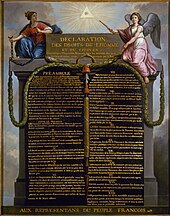
- 1788–1789:A Qing attempt to reinstall an exiledVietnamese kingin northern Vietnamends in disaster.
- 1789:George Washingtonis elected the firstPresident of the United States;he serves until1797.
- 1789:Quang Trungdefeats theQingarmy.
- 1789–1799:French Revolution.
- 1789:TheLiège Revolution.
- 1789:TheBrabant Revolution.
- 1789:TheInconfidência Mineira,an unsuccessful separatist movement in central Brazil led byTiradentes
- 1791:Suppression of theLiège RevolutionbyAustrianforces and re-establishment of thePrince-Bishopric of Liège.
- 1791–1795:George Vancouverexplores the world during theVancouver Expedition.
- 1791–1804:TheHaitian Revolution.
- 1791:Mozart premieresThe Magic Flute.
- 1792–1802:TheFrench Revolutionary Warslead into theNapoleonic Wars,which last from1803–1815.
- 1792:TheNew York Stock & Exchange Boardis founded.
- 1792:Polish–Russian War of 1792.
- 1792:Margaret Ann Neve(1792–1903) would become the first recorded femalesupercentenarianto reach the age of 110.[27][28]
- 1793:Upper Canadabans slavery.
- 1793:The largestyellow fever epidemicin American history kills as many as 5,000 people inPhiladelphia,roughly 10% of the population.[29]
- 1793–1796:Revolt in the Vendéeagainst the French Republic at the time of theRevolution.
- 1794–1816:TheHawkesbury and Nepean Wars,which were a series of incidents between settlers andNew South Wales Corpsand theAboriginal Australianclans of theHawkesbury riverinSydney,Australia.
- 1795:TheMarseillaiseis officially adopted as the Frenchnational anthem.

Napoleonat theBridge of the Arcole - 1795:TheBattle of Nuʻuanuin the final days of KingKamehameha I's wars tounifythe Hawaiian Islands.
- 1795–1796:Iran invades and devastates Georgia,promptingRussia to intervene and march on Tehran.
- 1796:Edward Jenneradministers the firstsmallpox vaccination;smallpoxkilled an estimated 400,000 Europeans each year during the 18th century, including five reigningmonarchs.[30]
- 1796:War of the First Coalition:TheBattle of MontenottemarksNapoleon Bonaparte's first victory as an army commander.
- 1796:The British eject the Dutch fromCeylonandSouth Africa.
- 1796–1804:TheWhite Lotus Rebellionagainst theManchu dynastyin China.
- 1798:TheIrish Rebellionfails to overthrowBritish rule in Ireland.
- 1798–1800:TheQuasi-Waris fought between the United States and France.
- 1799:Dutch East India Companyis dissolved.
- 1799:Austro-Russianforces underAlexander Suvorovliberates much of Italy and Switzerlandfrom French occupation.
- 1799:Coup of 18 Brumaire-Napoleon'scoup d'etatbrings the end of theFrench Revolution.
- 1799:Death of the Qianlong Emperor after60 years of rule over China.His favorite official,Heshen,is ordered to commit suicide.
- 1800:On 1 January, the bankrupt VOC is formally dissolved and the nationalizedDutch East Indiesare established.[31]
Inventions, discoveries, and introductions[edit]

- 1709:The firstpianowas built byBartolomeo Cristofori
- 1711:Tuning forkwas invented byJohn Shore
- 1712:Steam engineinvented byThomas Newcomen
- 1714:Mercury thermometerbyDaniel Gabriel Fahrenheit
- 1717:Diving bellwas successfully tested byEdmond Halley,sustainable to a depth of 55 ft
- c.1730:Octantnavigational tool was developed byJohn Hadleyin England, andThomas Godfreyin America
- 1733:Flying shuttleinvented byJohn Kay
- 1736:Europeans encounteredrubber– the discovery was made byCharles Marie de La Condaminewhile on expedition in South America. It was named in1770byJoseph Priestley
- c.1740:Modernsteelwas developed byBenjamin Huntsman
- 1741:Vitus Beringdiscovers Alaska
- 1745:Leyden jarinvented byEwald Georg von Kleistwas the first electricalcapacitor
- 1751:Jacques de Vaucansonperfects the first precisionlathe
- 1752:Lightning rodinvented byBenjamin Franklin
- 1753:The firstclockto be built in the New World (North America) was invented byBenjamin Banneker.
- 1755:The tallestwoodenBodhisattvastatue in the world is erected atPuning Temple,Chengde,China.
- 1764:Spinning jennycreated byJames Hargreavesbrought on theIndustrial Revolution
- 1765:James Wattenhances Newcomen's steam engine, allowing newsteeltechnologies
- 1761:The problem oflongitudewas finally resolved by the fourthchronometerofJohn Harrison
- 1763:Thomas Bayespublishes first version ofBayes' theorem,paving the way forBayesian probability
- 1768–1779:James Cookmapped the boundaries of the Pacific Ocean and discovered manyPacific Islands
- 1774:Joseph Priestleydiscovers "dephlogisticated air", oxygen
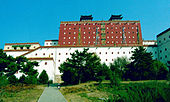
- 1775:Joseph Priestley's first synthesis of "phlogisticated nitrous air",nitrous oxide,"laughing gas"
- 1776:First improved steam engines installed byJames Watt
- 1776:Steamboatinvented byClaude de Jouffroy
- 1777:Circular sawinvented by Samuel Miller
- 1779:Photosynthesiswas first discovered byJan Ingenhousz
- 1781:William Herschelannounces discovery of Uranus
- 1784:Bifocalsinvented byBenjamin Franklin
- 1784:Argand lampinvented byAimé Argand[32]
- 1785:Power loominvented byEdmund Cartwright
- 1785:Automatic flour millinvented byOliver Evans
- 1786:Threshing machineinvented byAndrew Meikle
- 1787:Jacques CharlesdiscoversCharles's law
- 1789:Antoine Lavoisierdiscovers the law of conservation of mass, the basis for chemistry, and begins modern chemistry
- 1798:Edward Jennerpublishes a treatise aboutsmallpoxvaccination
- 1798:TheLithographic printing processinvented byAlois Senefelder[33]
- 1799:Rosetta Stonediscovered byNapoleon's troops
Literary and philosophical achievements[edit]
- 1703:The Love Suicides at SonezakibyChikamatsufirst performed
- 1704–1717:One Thousand and One Nightstranslated into French byAntoine Galland.The work becomes immensely popular throughout Europe.
- 1704:A Tale of a TubbyJonathan Swiftfirst published
- 1712:The Rape of the LockbyAlexander Pope(publication of first version)
- 1719:Robinson CrusoebyDaniel Defoe
- 1725:The New SciencebyGiambattista Vico
- 1726:Gulliver's TravelsbyJonathan Swift
- 1728:The DunciadbyAlexander Pope(publication of first version)
- 1744:A Little Pretty Pocket-Bookbecomes one of the firstbooks marketed for children
- 1748:Chushingura(The Treasury of Loyal Retainers), popular Japanesepuppet play,composed
- 1748:ClarissabySamuel Richardson
- 1749:The History of Tom Jones, a FoundlingbyHenry Fielding
- 1751:Elegy Written in a Country ChurchyardbyThomas Graypublished
- 1751–1785:The FrenchEncyclopédie
- 1755:A Dictionary of the English LanguagebySamuel Johnson
- 1758:Arithmetika HorvatzkabyMihalj Šilobod Bolšić
- 1759:CandidebyVoltaire
- 1759:The Theory of Moral SentimentsbyAdam Smith
- 1759–1767:Tristram ShandybyLaurence Sterne
- 1762:Emile: or, On EducationbyJean-Jacques Rousseau
- 1762:The Social Contract, Or Principles of Political RightbyJean-Jacques Rousseau
- 1774:The Sorrows of Young WertherbyGoethefirst published
- 1776:Ugetsu Monogatari(Tales of Moonlight and Rain) byUeda Akinari
- 1776:The Wealth of Nations,foundation of the modern theory of economy, was published byAdam Smith
- 1776–1789:The History of the Decline and Fall of the Roman Empirewas published byEdward Gibbon
- 1779:Amazing Gracepublished byJohn Newton
- 1779–1782:Lives of the Most Eminent English PoetsbySamuel Johnson
- 1781:Critique of Pure ReasonbyImmanuel Kant(publication of first edition)
- 1781:The RobbersbyFriedrich Schillerfirst published
- 1782:Les Liaisons dangereusesbyPierre Choderlos de Laclos
- 1786:Poems, Chiefly in the Scottish DialectbyRobert Burns
- 1787–1788:The Federalist PapersbyAlexander Hamilton,James Madison,andJohn Jay
- 1788:Critique of Practical ReasonbyImmanuel Kant
- 1789:Songs of InnocencebyWilliam Blake
- 1789:The Interesting Narrative of the Life of Olaudah EquianobyOlaudah Equiano
- 1790:Journey from St. Petersburg to MoscowbyAlexander Radishchev
- 1790:Reflections on the Revolution in FrancebyEdmund Burke
- 1791:Rights of ManbyThomas Paine
- 1792:A Vindication of the Rights of WomanbyMary Wollstonecraft
- 1794:Songs of ExperiencebyWilliam Blake
- 1798:Lyrical BalladsbyWilliam WordsworthandSamuel Taylor Coleridge
- 1798:An Essay on the Principle of Populationpublished byThomas Malthus
- (mid–18th century):The Dream of the Red Chamber(authorship attributed toCao Xueqin), one of the most famous Chinese novels
Musical works[edit]
- 1711:Rinaldo,Handel's first opera for the London stage, premiered
- 1721:Brandenburg ConcertosbyJ.S. Bach
- 1723:The Four Seasons,violin concertos byAntonio Vivaldi,composed
- 1724:St John PassionbyJ.S. Bach
- 1727:St Matthew Passioncomposed byJ.S. Bach
- 1727:Zadok the Priestis composed byHandelfor the coronation ofGeorge II of Great Britain.It has been performed at every subsequent British coronation.
- 1733:Hippolyte et Aricie,first opera byJean-Philippe Rameau
- 1741:Goldberg Variationsforharpsichordpublished byBach
- 1742:Messiah,oratorio byHandelpremiered inDublin
- 1749:Mass in B minorbyJ.S. Bachassembled in current form
- 1751:The Art of FuguebyJ.S. Bach
- 1762:Orfeo ed Euridice,first "reform opera" byGluck,performed inVienna
- 1786:The Marriage of Figaro,opera byMozart
- 1787:Don Giovanni,opera byMozart
- 1788:Jupiter Symphony(Symphony No. 41)composed byMozart
- 1791:The Magic Flute,opera byMozart
- 1791–1795:London symphoniesbyHaydn
- 1798:ThePathétique,piano sonata byBeethoven
- 1798:The Creation,oratorio byHaydnfirst performed
References[edit]
- ^Volkov, Sergey.Concise History of Imperial Russia.
- ^Rowe, William T.China's Last Empire.
- ^Anderson, M. S. (1979).Historians and Eighteenth-Century Europe, 1715–1789.Oxford University Press.ISBN978-0-19-822548-5.OCLC185538307.
- ^Ribeiro, Aileen (2002).Dress in Eighteenth-Century Europe 1715–1789(revised ed.). Yale University Press.ISBN978-0-300-09151-9.OCLC186413657.
- ^Baines, Paul (2004).The Long 18th Century.London: Arnold.ISBN978-0-340-81372-0.
- ^Marshall, P. J., ed. (2001).The Oxford History of the British Empire: Volume II: The Eighteenth Century (Oxford History of the British Empire).Oxford University Press, USA.ISBN978-0-19-924677-9.OCLC174866045.,"Introduction" by P. J. Marshall, page 1
- ^O'Gorman, Frank (1997).The Long Eighteenth Century: British Political and Social History 1688–1832 (The Arnold History of Britain Series).A Hodder Arnold Publication.ISBN978-0-340-56751-7.OCLC243883533.
- ^abChandra, Bipin.Mordern India.India.
- ^Campbell, John;Watts, William (1760).Memoirs of the Revolution in Bengal, anno Dom. 1757.A. Millar, London.
- ^Parthasarathi, Prasannan (2011),Why Europe Grew Rich and Asia Did Not: Global Economic Divergence, 1600–1850,Cambridge University Press,p. 207,ISBN978-1-139-49889-0
- ^Allana, Gulam (1988).Muslim political thought through the ages: 1562–1947(2 ed.). Pennsylvania State University, Pennsylvania: Royal Book Company. p. 78.ISBN9789694070919.Retrieved18 January2013.
- ^"War of the Spanish Succession, 1701–1714".Historyofwar.org.Retrieved25 April2009.
- ^Ricklefs (1991), page 82
- ^Historic uk – heritage of britain accommodation guide (3 May 2007)."The history of Scotland – The Act of Union 1707".Historic-uk.Archivedfrom the original on 8 April 2009.Retrieved25 April2009.
- ^Ricklefs (1991), page 84
- ^"Welcome to Encyclopædia Britannica's Guide to History".Britannica.31 January 1910.Archivedfrom the original on 16 April 2009.Retrieved25 April2009.
- ^"List of Wars of the Crimean Tatars".Zum.de.Archivedfrom the original on 12 March 2009.Retrieved25 April2009.
- ^"Len Milich: Anthropogenic Desertification vs 'Natural' Climate Trends".Ag.arizona.edu. 10 August 1997. Archived fromthe originalon 11 February 2012.Retrieved25 April2009.
- ^Wadsworth, Alfred P.; Mann, Julia De Lacy (1931).The Cotton Trade and Industrial Lancashire, 1600–1780.Manchester University Press.p. 433.OCLC2859370.
- ^"A guide to Scottish clans".Unique-cottages.co.uk. Archived fromthe originalon 11 May 2008.Retrieved25 April2009.
- ^"Saudi Arabia – The Saud Family and Wahhabi Islam".Countrystudies.us.Retrieved25 April2009.
- ^"History".Columbia University.
- ^Ricklefs (1991), page 102
- ^"Sufism in the Caucasus".Islamicsupremecouncil.org. Archived fromthe originalon 23 February 2009.Retrieved25 April2009.
- ^"Table A – Verified Supercentenarians (Listed Chronologically By Birth Date)".Archived fromthe originalon 12 July 2016.Retrieved9 November2016.
- ^Photo Gallery for Supercentenarians born before 1850, as of May 17, 2019
- ^Balfour-Pau, Glen (20 December 2005).Bagpipes in Babylon: A Lifetime in the Arab World and Beyond.I.B.Tauris, 2006.ISBN9781845111519.
- ^"The Harvey Family".Priaulx Library.2005. Archived fromthe originalon 22 October 2013.
- ^"Yellow Fever Attacks Philadelphia, 1793".EyeWitness to History.Archivedfrom the original on 7 June 2007.Retrieved22 June2007.
- ^Riedel S (2005)."Edward Jenner and the history of smallpox and vaccination".Proc (Bayl Univ Med Cent).18(1): 21–5.doi:10.1080/08998280.2005.11928028.PMC1200696.PMID16200144.
- ^Ricklefs (1991), page 106
- ^Encyclopædia Britannica's Great Inventions,Encyclopædia BritannicaArchivedAugust 7, 2008, at theWayback Machine
- ^Meggs, Philip B. A History of Graphic Design. (1998) John Wiley & Sons, Inc. p 146ISBN978-0-471-29198-5
Further reading[edit]
- Black, Jeremy and Roy Porter, eds.A Dictionary of Eighteenth-Century World History(1994) 890pp
- Klekar, Cynthia. "Fictions of the Gift: Generosity and Obligation in Eighteenth-Century English Literature." Innovative Course Design Winner.American Society for Eighteenth-Century Studies:Wake Forest University, 2004. <Home | American Society for Eighteenth-Century Studies (ASECS)>. Refereed.
- Langer, William.An Encyclopedia of World History(5th ed. 1973); highly detailed outline of eventsonline free
- Morris, Richard B. and Graham W. Irwin, eds.Harper Encyclopedia of the Modern World: A Concise Reference History from 1760 to the Present(1970)online
- Milward, Alan S, and S. B. Saul, eds.The economic development of continental Europe: 1780–1870(1973)online;note there are two different books with identical authors and slightly different titles. Their coverfage does not overlap.
- Milward, Alan S, and S. B. Saul, eds.The development of the economies of continental Europe, 1850–1914(1977)online
- The Wallace Collection,London, houses one of the finest collections of 18th-century decorative arts from France, England and Italy, including paintings, furniture, porcelain and gold boxes.
External links[edit]
 Media related to18th centuryat Wikimedia Commons
Media related to18th centuryat Wikimedia Commons
